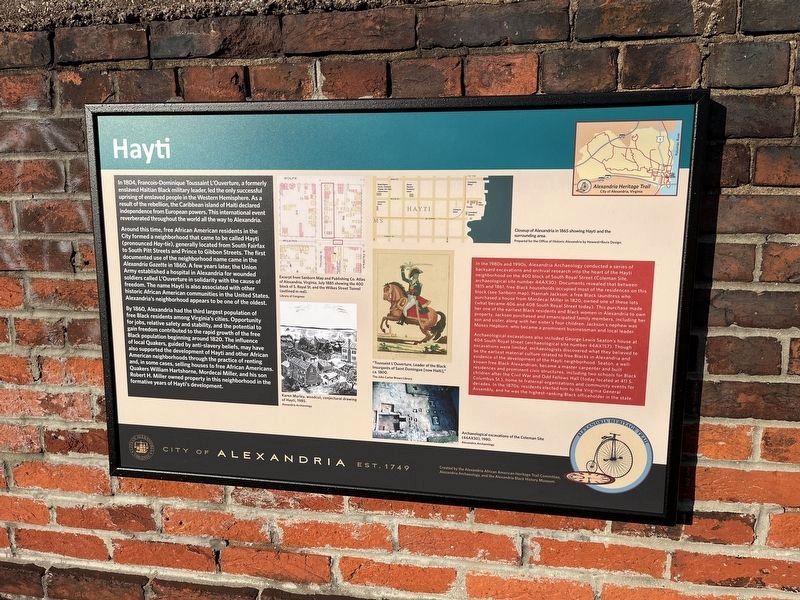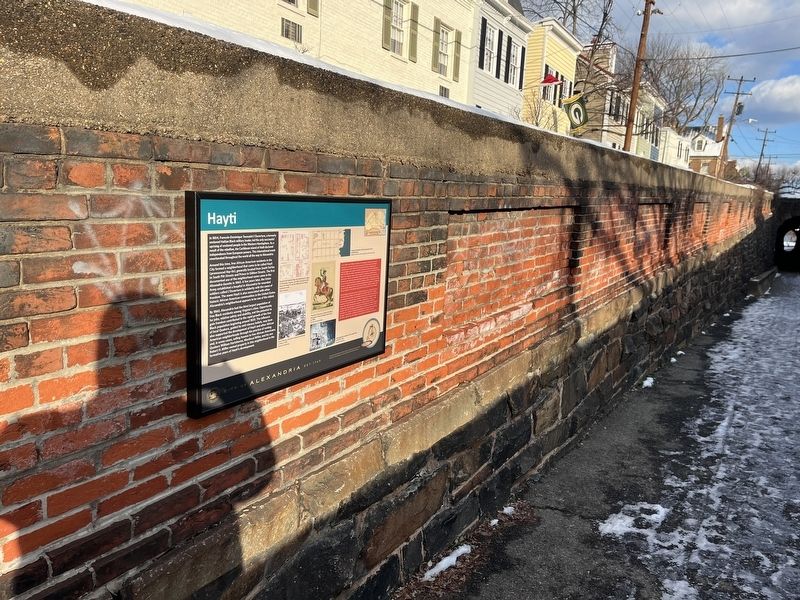Old Town in Alexandria, Virginia — The American South (Mid-Atlantic)
Hayti
City of Alexandria, est. 1749
— Alexandria Heritage Trail —
In 1804, Francois-Dominique Toussaint L'Ouverture, a formerly enslaved Haitian Black military leader, led the only successful uprising of enslaved people in the Western Hemisphere. As a result of the rebellion, the Caribbean island of Haiti declared independence from European powers. This international event reverberated throughout the world all the way to Alexandria.
Around this time, free African American residents in the City formed a neighborhood that came to be called Hayti (pronounced Hay-tie), generally located from South Fairfax to South Pitt Streets and Prince to Gibbon Streets. The first documented use of the neighborhood name came in the Alexandria Gazette in 1860. A few years later, the Union Army established a hospital in Alexandria for wounded soldiers called L'Ouverture in solidarity with the cause of freedom. The name Hayti is also associated with other historic African American communities in the United States. Alexandria's neighborhood appears to be one of the oldest.
By 1860, Alexandria had the third largest population of free Black residents among Virginia's cities. Opportunity for jobs, relative safety and stability, and the potential to gain freedom contributed to the rapid growth of the free Black population beginning around 1820. The influence of local Quakers, guided by anti-slavery beliefs, may have also supported the development of Hayti and other African American neighborhoods through the practice of renting and, in some cases, selling houses to free African Americans. Quakers William Hartshorne, Mordecai Miller, and his son Robert H. Miller owned property in this neighborhood in the formative years of Hayti's development.
In the 1980s and 1990s, Alexandria Archaeology conducted a series of backyard excavations and archival research into the heart of the Hayti neighborhood on the 400 block of South Royal Street (Coleman Site, archaeological site number 44AX30). Documents revealed that between 1815 and 1861, free Black households occupied most of the residences on this block (see Sanborn map). Hannah Jackson, a free Black laundress who purchased the house from Mordecai Miller in 1820, owned one of these lots (what became 406 and 408 South Royal Street today). This purchase made her one of the earliest Black residents and Black women in Alexandria to own property. Jackson purchased and emancipated family members, including her son and sister, along with her sister's four children. Jackson's nephew was Moses Hepburn, who became a prominent businessman and local leader.
Archaeological excavations also included George Lewis Seaton's house at 404 South Royal Street (archaeological site number 44AX157). Though excavations were
Erected by City of Alexandria, Virginia. (Marker Number 9.)
Topics and series. This historical marker is listed in these topic lists: African Americans • Churches & Religion • Settlements & Settlers • Wars, Non-US. In addition, it is included in the Quakerism, and the Virginia, The City of Alexandria series lists. A significant historical year for this entry is 1804.
Location. 38° 48.005′ N, 77° 2.664′ W. Marker is in Alexandria, Virginia. It is in Old Town. Marker is on Wilkes Street east of South Royal Street, in the median. The marker hangs on the right wall of the aboveground section of the Wilkes Street tunnel when heading west toward South Royal Street. Touch for map. Marker is at or near this postal address: 323 Wilkes Street, Alexandria VA 22314, United States of America. Touch for directions.
Other nearby markers. At least 8 other markers are within walking distance of this marker. Wilkes Street Tunnel (here, next to this marker); Orange & Alexandria Roundhouse (a few steps from this marker); Alexandria Railroads (a few steps from this marker); African American Neighborhoods in the Civil War (about 600 feet away, measured in a direct line); First Presbyterian Church of Alexandria (about 600 feet away); Saint Mary's Catholic Parish (about 700 feet away); a different marker also named Wilkes Street Tunnel (about 700 feet away); "For God and Country" (approx. 0.2 miles away). Touch for a list and map of all markers in Alexandria.
Credits. This page was last revised on January 21, 2024. It was originally submitted on January 21, 2024, by Devry Becker Jones of Washington, District of Columbia. This page has been viewed 80 times since then. Photos: 1, 2. submitted on January 21, 2024, by Devry Becker Jones of Washington, District of Columbia.

